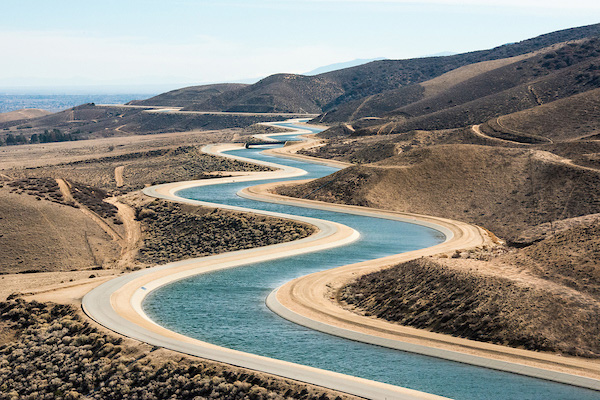
A serpentine stretch of the California Aqueduct in Palmdale, Calif. within Los Angeles County at mile post 327.50
Source: DWR/2014
December 20, 2020 - By Christine Souza - Amid long-term forecasts indicating California could be headed into another dry winter, discussions at the California Farm Bureau Annual Meeting focused on current and future water policy and the challenges facing short- and long-term supplies.
During a breakout session as part of the virtual Annual Meeting, Ernest Conant, U.S. Bureau of Reclamation regional director for the California-Great Basin Region, described how regulatory constraints have affected water allocations from the federal Central Valley Project.
"If you compare the early 1990s, when we were in a severe drought, we were able to make some nominal deliveries, compared to the most recent drought in 2014-15, when we were not able to make any deliveries to south of delta and north of delta" water contractors, he said.
Conant also discussed litigation brought by the state of California after federal agencies released updated biological opinions for management of water to aid protected fish in the Sacramento-San Joaquin river system. Environmental groups and the state challenged the 2019 opinions, seeking a return to previous opinions and possible reductions in water deliveries.
Describing the development of new operating rules for the project as "one of our largest accomplishments for our region in some time," Conant said the resulting management plan "brings greater efficiency to water delivery by modifying and coordinating long-term operations of the CVP and (State Water Project), and includes the newest science to ensure updated operations are achieved and to achieve a reasonable balance among competing demands for use of CVP water."
Conant said the federal agencies hope to resolve the litigation from the state and "to return to the extraordinary progress that was made in 2018 through the voluntary-agreement process in collaboratively updating the water quality control plan for the bay-delta."
Voluntary agreements would serve as an alternative to "unimpaired flows" plans by the State Water Resources Control Board. A first phase of the water board plan, adopted in 2018, would require water users in San Joaquin River tributaries to leave 30% to 50% of unimpaired flows in the Stanislaus, Tuolumne and Merced rivers for fish populations, unless voluntary agreements on the three tributaries can be reached and adopted instead. A second phase proposes similar unimpaired-flow requirements for the Sacramento River watershed of approximately 55%.
"There can be no voluntary agreements without resolution of this litigation from the state," Conant warned.
During a separate session, California Farm Bureau Senior Counsel Chris Scheuring agreed that the state-federal delta litigation "hamstrings voluntary agreements."
Scheuring said Farm Bureau filed a lawsuit with more than a dozen other groups on the unimpaired-flows regulation, adding that Farm Bureau supports a "functional flows" approach found in the voluntary agreements.
In his presentation to the Farm Bureau meeting, Conant said Gov. Gavin Newsom's Water Resiliency Portfolio endorses voluntary agreements as the path forward.
Through the water portfolio, Conant said, the governor has shown an interest in taking a leadership role to address California's water challenges, through conservation, diversity of supplies and new storage, such as construction of Sites Reservoir.
"It is clear that California needs more storage and expanding areas where the existing storage exists. That's why we continue to explore options for funding," Conant said.
Funds from the 2014 Proposition 1 water bond will help fund several new and expanded storage facilities, including Sites, and Conant discussed planned federal projects such as expanding capacity of Shasta and San Luis reservoirs.
"The department's highest priorities in the last few years have been to invest in and modernize our water infrastructure to ensure reliable water supplies," he said, pointing out that in many cases, Bureau of Reclamation infrastructure is 60 to 100 years old.
The bureau also plans to restore stretches of the Friant-Kern Canal and Delta-Mendota Canal, which have lost capacity due to subsidence.
In the other Annual Meeting session, California Farm Bureau Federal Policy Consultant Erin Huston said water infrastructure development could be among the priorities of the incoming 117th Congress.
In addition, Huston reported speculation that the new Biden administration could "repeal and replace" the Trump administration's version of the waters of the U.S. rule under the Clean Water Act. The current rule updated a 2015 Obama administration rule that drew widespread concern from agricultural groups and others for greatly expanding federal jurisdiction over water, land and land use.
"They could do a repeal and replace of the rule or a modification in the areas in which they disagree, which, broadly speaking, seems to be around the issue of jurisdiction and includes which bodies of water are considered navigable and which bodies are not," Huston said.
During his session, Conant said there is a growing confidence that moderate to strong La Niña conditions in the Pacific Ocean substantially increase the odds of a dry winter.
"Some reservoirs are above average, some are below, but it's extremely early in the season," he said. "Reclamation is already planning for a potential dry winter by decreasing river releases and conserving storage to the greatest extent possible."
Discussions of water supply and policy inevitably led to California's groundwater law, the Sustainable Groundwater Management Act or SGMA.
If no action is taken to build new storage or update water infrastructure, Conant said, "up to a million acres of land may need to be retired in order to achieve water balance."
"If some projects are implemented that they're pursuing over the next 10 years, and if the biological opinions are upheld, that number can be cut about in half as to the number of acres that would need to be retired in order to achieve a water balance," he said. "We cannot lose sight of the profound economic and social effects that will have."
(Christine Souza is an assistant editor of Ag Alert. She may be contacted at csouza@csouza@cfbf.com.)
Reprinted with permission: California Farm Bureau Federation








